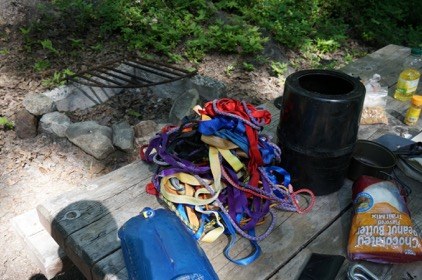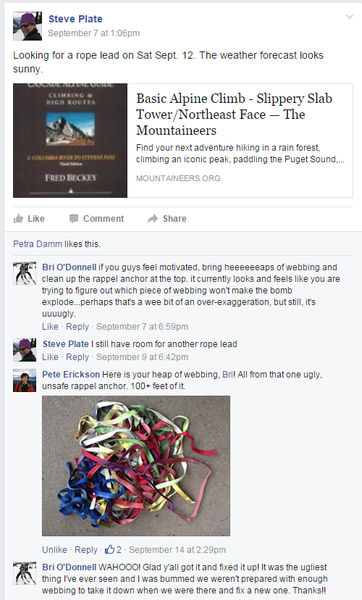
Leave No Trace isn't just for orange peels or poop. It applies to all facets of our outdoor explorations. Climbing is unique because it is one of the few outdoor sports where you often must leave gear or webbing behind to descend safely. Consequently, the climbing community must work as a team to limit our collective impact, especially on our popular climbing routes.
A pile of fraying and worn webbing isn't only aesthetically unpleasing, it's also unsafe. Excess webbing makes it hard to see the anchor or check its relability. As a climber, you want to know your anchor is firm - that the tree is solidly rooted in the side of the mountain or the chockstone is uncracked - before weighting an anchor.
If you are unsure whether the current webbing or cord will hold, it's absolutely a good idea to add a new sling that you trust. However a good rule of thumb is
if you add a sling, remove a sling"
Some webbing is obviously frayed or very discolored, but if you have any doubt do NOT use it. UltraViolet light from the sun is powerful enough to impact webbing strength. If you aren't sure go ahead and feel it. Webbing will become stiff when it's seen a lot of UV. You can also check discoloration by moving the knot to see the original webbing color.
More tips for limiting your impact:
Stay on route
A common rappel route will have established rappel stations every rope length. However, you may see additional tat (tat: old pieces of webbing or other ad-hoc anchor remnant) either next to or along the route as a result of climbers getting off-route or "out of sync" with the established stations. While it may be easier and quicker to rejoin the established rappel route further down, when possible you should retrace your steps to rejoin the established route. Similarly, when you find yourself off-route above the correct ledge or gully, resist the temptation to leave a sling and take a rappel shortcut back to the route.
Clean as you go
Don't leave unnecessary webbing if you don't need to. If your first leader has set up a handline or short rappel to move through steep scramble terrain but the leader is comfortable downclimbing, then the leader should remove tat and descend the terrain unaided. Only do this when all members of the team are comfortable - safety of the team is the number one priority.
Use your network
If you discover a rappel station that looks like it could use some love, but you find yourself without a knife or adequate tools, let your fellow climbers know! Share a trip report, email to a leader who has an upcoming trip, or post to an online forum.
Check out this great example which resulted in 100+ feet of webbing being removed from Lundin Peak. The main blog picture is webbing removed from Bonanza from Sean O'Rourke who inspired this blog post.

Way to go Bri for bringing this to everyone's attention, and nice work Steve and Pete for cleaning it up for future climbers!
 Tess Wendel
Tess Wendel